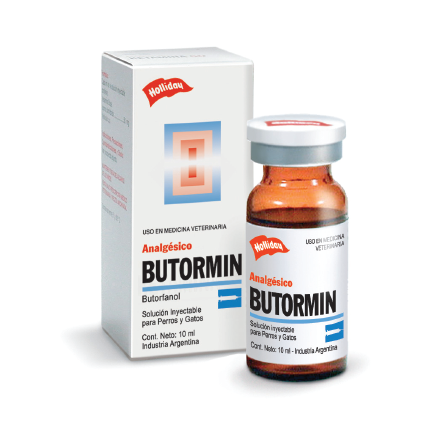Categories
- Anesthetic | Analeptic | Tranquilizer
- Anti-inflamatory
- Antibiotic
- Antimycotics
- Antiseptic Disinfectant
- Biomodulator
- Bird Medication
- Cardiological
- Dermatological
- External Antiparasitic
- Gastroenterological
- Geriatrical
- Health & Wellness
- Internal Antiparasitic
- Odontological
- Oncology Medication
- Ophthalmological
- Osteoarticular
- Otological
- Prescribed Diets
- Reproductive System
- Respiratory System
- Revitalizer
- Urinary System and Diuretics
Antiinflamatorios | Analgésicos

BUTORMIN
description
Butorphanol-based analgesic for injection.
presentation
10 mL vial.
action
Analgesic, agonist-antagonist synthetic opioid more potent than morphine with minimum cardiovascular side effects. Kappa-agonist: The activation of Kappa receptors induces spinal analgesia and sedation with less respiratory depression and myosis. Mu antagonist: The stimulation of MU receptors induces supra-spinal analgesia, respiratory depression and myosis, physical dependence and euphoria.
indications
Pre-, intra- and postoperative analgesia.
It can be administered along with premedication. To enhance the sedative effects of tranquilizers: Midazolam - Diazepam – Acepromazine.In combination with Acepromazine, it improves sedation, particularly in medium and large dog breeds. It can be combined with Ketamine during anesthesia.
formula
100 mL of solution contains:
Butorphanol tartrate 1.02 g
Excipients q.s.
dosage and administration
Dogs: Preanesthetic 0.1 a 0.2 mg/kg. Analgesia: 0.2 to 0.4 mg/kg (intravenous, intramuscular or subcutaneous administration).
Cats: Pre-anesthesia 0.1 - 0.2 mg/kg, intramuscular administration. Analgesia: 0.1 - 0.2 mg/kg, intravenous or intramuscular administration or 0.4 mg/kg for subcutaneous administration. With intramuscular administration it reaches analgesia after 30 minutes witha peak effect 1 hour after administration. Intravenous administration delivers an immediate effect. Slow administration by this route is advised. It does not cause respiratory depression.
contraindications
It should not be used in patients with severe liver disease, serious renal failure, heart failure or obstructive respiratory diseases. Do not use in pregnant females since there are no studies on its effects on this group.
collateral damage
It may cause ataxia and anorexia. In rare occasions, it causes diarrhea or decreased intestinal mobility.
In cats, butorphanol may cause excitement and dilated pupils (rarely).
restrictions on use
Animals with hypothyroidism, serious renal failure, and geriatric animals.
Caution
In animals sensitive to butorphanol. Use with caution in puppies and kittens.

